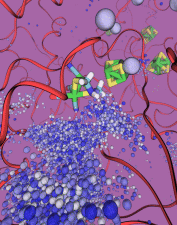TCBG Software at SC2005
NAMD/VMD-based SPICE wins the HPC Analytics Challenge Award at SC|05

|
SC2005 Talks and Demonstrations
|
NIH National Center for Research Resources Booth Presentations
The Theoretical and Computational Biophysics Group (TCBG), an NIH Resource for Macromolecular Modeling and Bioinformatics, is located at the Beckman Institute of the University of Illinois at Urbana-Champaign (UIUC). The Resource brings advanced molecular modeling, bioinformatics, and computational technologies to bear on questions of biomedical relevance through direct collaboration with experimental researchers, the distribution of user-friendly cutting-edge software, and a broad range of training and dissemination activities.
The flagship TCBG software packages NAMD, VMD, and BioCoRE, all distributed free of charge with source code, facilitate the discovery process from analysis, through modeling, to visualization of the molecular apparatus in biological cells:
- NAMD, recipient of a 2002 Gordon Bell Award, is a parallel molecular dynamics code used regularly to simulate systems of 300,000 atoms and beyond on both large supercomputers and inexpensive Linux clusters.
- VMD is a molecular visualization program for displaying, animating, and analyzing large biomolecular systems using hardware-accelerated 3-D graphics and built-in scripting.
- BioCoRE is a collaborative work environment that allows biomedical researchers to visualize information, to share resources, and to interact with each other and with research tools via a common infrastructure and across distance.
For improved VMD performance on the tiled display use "display cachemode on"; this is primarily useful for rotating static structures.
NCSA and TeraGrid Booth Presentations
TeraGrid booth (#662, level 4, far north end, near hotel tower)
 Researchers at the Theoretical and Computational Biophysics Group at the
University of Illinois (TCBG) are now able to image gas transport
pathways inside proteins, which has many implications for biotechnology and
science. For this research, a large number of simulations need to be
run and monitored, and the traditional means of doing so is very wasteful of
the researchers' time. To solve this problem, a grid submission engine
(NAMD-G) targeted towards biomolecular simulations running the NAMD software,
has been developed by NCSA in collaboration with TCBG personnel.
From the researchers' host machines, NAMD-G can farm out a large
number of jobs, in parallel, to the Linux clusters at NCSA and to other
supercomputers on the TeraGrid. In addition, NAMD-G monitors and
manages multiple sequences of linked simulation jobs, and performs the
necessary transfers and backups on all of their associated files on an
as-needed basis. During this presentation, the scientific backround of the gas
transport process, the NIH-supported, freely available (at www.ks.uiuc.edu)
NAMD and VMD software, and the NAMD-G submission engine running live,
will all be showcased.
Researchers at the Theoretical and Computational Biophysics Group at the
University of Illinois (TCBG) are now able to image gas transport
pathways inside proteins, which has many implications for biotechnology and
science. For this research, a large number of simulations need to be
run and monitored, and the traditional means of doing so is very wasteful of
the researchers' time. To solve this problem, a grid submission engine
(NAMD-G) targeted towards biomolecular simulations running the NAMD software,
has been developed by NCSA in collaboration with TCBG personnel.
From the researchers' host machines, NAMD-G can farm out a large
number of jobs, in parallel, to the Linux clusters at NCSA and to other
supercomputers on the TeraGrid. In addition, NAMD-G monitors and
manages multiple sequences of linked simulation jobs, and performs the
necessary transfers and backups on all of their associated files on an
as-needed basis. During this presentation, the scientific backround of the gas
transport process, the NIH-supported, freely available (at www.ks.uiuc.edu)
NAMD and VMD software, and the NAMD-G submission engine running live,
will all be showcased.



